|
Email not displaying correctly?
Click here to view it in your browser. To ensure delivery to your inbox please add moderator@eastgippsland.net.au to your address book |

|
 |
|
We had a small distraction of a bushfire out here over the summer so sorry about the lack of forest news and updates. You can read about the fire and its management below (and see the images via a link). But despite the fires, lack of internet for 6 weeks, being 2 months behind with farm tasks, the EEG office is still pumping. We’re writing more ‘please explain’ letters to govts, applying for FOI requests, sending in submissions (helps to show we tried when things get to court), mapping fire severity and trying to piece together the sequence and influences, questioning many of the planned burns, having input into the FSC process (wood certification for VicForests), networking with forests/carbon/climate groups and of course cooking up the next legal case against VicForests. We don’t want to swamp people with too much news all at once, so will send more through after Easter. In this bulletin: Good news
Wanted
Forests Forever 2014 The fires haven’t taken everything – we are still holding our annual ecology camp by the Brodribb River. We’d love to see you up here. Bookings are essential though. Click here for more details and to grab your spot. 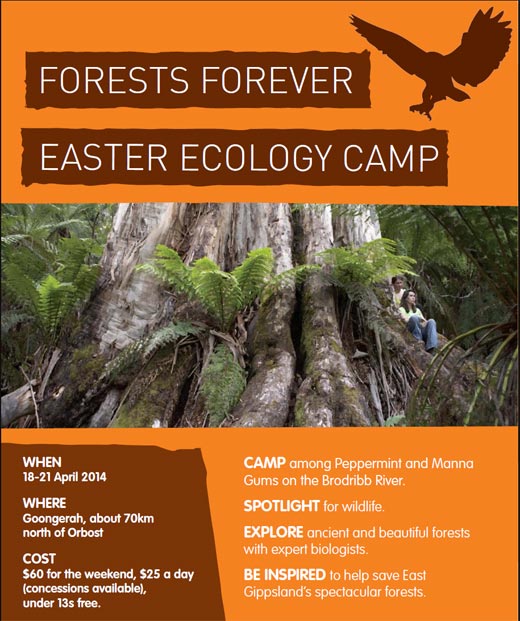 Good news Minister Walsh says 'Sorry'  False and misleading comments made by Minister Peter Walsh against EEG last October have finally resulted in him stepping back and making a public apology. People have asked if an apology was all we received but unfortunately we are unable to comment on that. All we can say is that we are happy with the outcome. The apology to Environment East Gippsland was published on his parliamentary website and in the East Gippsland local papers in early March. The Minister’s media comments in October last year stated that EEG “…continue(s) to attack Victoria’s responsible and sustainable native forest industry, often wasting hundreds of thousands of taxpayer dollars”. In the apology, he retracted those and other statements. Read more on our website here and read the Herald Sun article here EG protesters receive a judge’s frown Protesters charged with being in a 'Public Safety Zone' (that’s a euphemism for a clearfell logging site) at Mt Jersey’s old growth forest last year, received good behaviour bonds in early March. At the hearing in the Orbost court, the bonds ranged from 3 to 12 months, which is fantastic (except for serial protestor Flynny, but that was slightly different). Also, no service costs were ordered and no costs were ordered for VicForests lawyers, despite them arguing for both. Thanks go to Danya from Bleyer Lawyers who did a fantastic job. They could not have gotten better results. Whale suffering to stop in our southern waters Everyone will have rejoiced at the news of the International Court of Justice declaring that Japan's Antarctic whaling program was not scientific research and should stop. Read more here If only the International Court of Justice would look at our government’s claim that forest logging is ‘sustainable’. Herald-Sun breakthrough! This is an amazing article for the Herald Sun to have published. It is a Murdoch paper which normally never covers environment stories let alone forests. It basically says it’s the survival of an entire possum species (the Leadbeaters Possum) vs cheap fodder for the Reflex pulp and paper factory. And it doesn't have much good to say about the government or industry! Well done Herald Sun (the journalist also won a media award the next week but it was unconnected – as much as we’d like to think so). 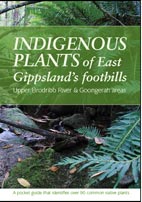 The local pocket guide to East Gippsland's native plants has been updated and reprinted. Available shortly. $6 plus p&p. Order online at the EEG shop. Fire news New research shows logging regrowth increases fire intensity Preliminary findings from a new study are showing that logging regrowth burns more intensely and these fires change our forests to be dry, flammable scrubland. The findings could also have massive implications for whole towns and communities in future fires where they are surrounded by forests managed for logging. 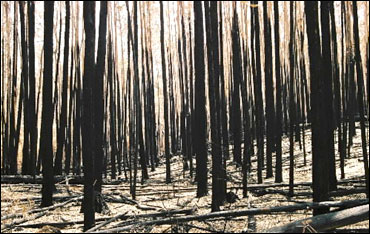 Researcher Dr Chris Taylor presented his preliminary findings at the third annual Australian Forests and Climate Forum at the Australian National University in mid January. The paper will soon be publishing in full.
Researcher Dr Chris Taylor presented his preliminary findings at the third annual Australian Forests and Climate Forum at the Australian National University in mid January. The paper will soon be publishing in full.He said bushfires in logging regrowth burnt with greater severity than those in older forests, which meant they were destroyed more completely. Climate change was causing bushfires in forests more often and, combined with the impact of logging, fewer will regenerate back to a eucalypt forest. Young regrowth burns more intensely and if it burns again within 20 years (as has been happening lately), it kills off the ash forests before seed can be produced. Read more here. 2014 Goongerah-Deddick fires A strange weather phenomenon over central Australia in January and February influenced SE Australia’s hot dry season. This, coupled with the January lightning storms across Victoria created another serious fire season this summer. The mid January storms saw 770 lightning strikes, slightly up on the 30 year average of around 600. Many of these self-extinguished or only burnt very small areas, others were rounded up and put out and in East Gippsland 10 became problems fires. The fire’s vital stats 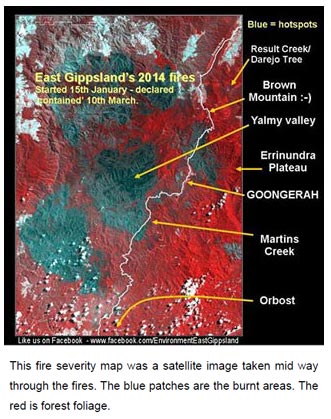
Statewide, 413,000 ha were burnt. This included the Mallee/Wyperfeld NP, the Grampains, Kilmore/Midlands fires, Mt Ray/Glenaladale Hearnes Oak/Hazelwood and in East Gippsland the largest being the Deddick/Goongerah fires. These 166,000ha burnt for 53 days until declared ‘contained’ on March 10th, leaving a seriously devastated landscape with an 850km boundary. Although there were around 800 or so fire fighting personnel, DEPI, Parks and CFA volunteers, it was inadequate for the task. Air strike capacity was also very limited due to the numerous fires. On the ground observations - destruction over destruction Goongerah has its own CFA brigade and tanker so we were able to observe and be part of fire fighting efforts on the ground. While the work of some govt personnel was quite amazing and appreciated, there was much that wasn’t. Many people were astounded at the way all green forest that had survived the main bushfire and were essential refuge areas for wildlife, were endlessly burnt by DEPI in the hottest driest conditions. As they don’t keep records of what areas these back-burns or black-outs devoured and what the real bushfire burnt, no one can ever determine accurately which was which. New fire control methods – bushfires by design. The new super-cautious policy seems to ensure that fire fighters these days rarely go near flames or use much water to put them out, but do a lot of patrolling tracks from 9-5pm. CFA volunteers are often left to do the night patrols. The new arrangement uses bulldozers galore to punch tracks through the forest, light fires along them and try to coral the bushfire with more fires, adding to the burning edge every day. These regularly escaped. So more bulldozer tracks were put in further out, and more fire lit to burn back in. This might be appropriate for a large bushfire, but after the threat passed, it continued for weeks. At best maybe a third to a half of the total burnt area was deliberately lit and at worst possibly three quarters of these destroyed forests were ‘bushfires by design’. We can accept that immediately adjoining private land, putting fire around the edges to burn out at a cooler time of day could be useful. But to keep these fires going along every unburnt track, gully, hillside and road miles from anywhere seems like unnecessary destruction. The valuable pockets of green that didn’t burn were wildlife refuges and actually dampened the fires run, yet were deliberately and systematically burnt as well. Wildlife victims 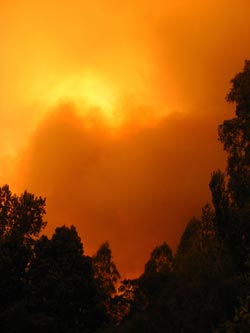 Some of us are now doing regular food drops out around burnt and semi burnt areas (near water) for the surviving wildlife (thanks to our donors who helped us buy the feed). In the high fire severity areas there was no uptake. This was extremely bad news for all life. There are no signs of gliders, possums, wallabies, wombats, potoroos or bandicoots. There are no tracks, no poo and no food uptake. That also means, birds would have perished, and a total wipe out of forest frogs, lizards, snakes, goannas. This type of burn severity goes for mile after mile after mile. It’s hard to imagine how these ecosystems will recover in anything less than 100 years. Leaves and bushes might grow back, but the entire finely-tuned ecosystem that operates unseen will take much longer. However the semi burnt areas closer in to the valley acted as a refuge and there are quite a few signs of survivors and they are taking the food drops regularly.
Some of us are now doing regular food drops out around burnt and semi burnt areas (near water) for the surviving wildlife (thanks to our donors who helped us buy the feed). In the high fire severity areas there was no uptake. This was extremely bad news for all life. There are no signs of gliders, possums, wallabies, wombats, potoroos or bandicoots. There are no tracks, no poo and no food uptake. That also means, birds would have perished, and a total wipe out of forest frogs, lizards, snakes, goannas. This type of burn severity goes for mile after mile after mile. It’s hard to imagine how these ecosystems will recover in anything less than 100 years. Leaves and bushes might grow back, but the entire finely-tuned ecosystem that operates unseen will take much longer. However the semi burnt areas closer in to the valley acted as a refuge and there are quite a few signs of survivors and they are taking the food drops regularly. Hollow tree loss As well as the immediate loss of wildlife, there was a considerable loss of large hollow tree habitat. This net loss of trees between 100-600 years old will have a further serious impact on the East Gippsland population of rare hollow dependent fauna. The thunderous sound of trees crashing down in the surrounding hills was constant all day and night for weeks. Whether DEPI burns or the bushfire, the hollowed base of these essential trees appeared to be burning out at the same rate. These are crucial for gliders, forest owls, the black cockatoos and so on. What the bushfire and DEPI burns didn’t take the bulldozers pushed over. Then whatever sturdy trees still survived all this and grew along the roads, the government’s new ‘dangerous trees’ policy saw chainsaws take them out – sturdy or not, leaning or straight. The Bonang Road is like a four-lane freeway in places. There appears to be no rhyme or reason to this. A new regional economy? However the fires did employ a lot of logging industry operators for many weeks. Even now operators are out there on rehabilitation work, pushing up trees, breach and barring tracks and repairing some of the damage as best as possible. When a fire is declared out of control and dangerous, it is taken over by the state control centre and money flows freely. These fires have so far cost between $60-70 million. They are quite a regional industry all on their own and welcomed by many businesses and locals. Autumn planned burns Many are rightly asking how this almost 200,000 ha of forest fires fits in with DEPI plans to do their controversial 5% targeted burns. We were told that the DEPI still plans to burn another 33,000 ha of forest and coastal areas up. Only 8,000 ha that were already on their plans and were burnt during the fires (by DEPI or the lightning strikes) will be taken off and the other 25,000 ha of planned burns will go ahead. There are also around 40 clearfelled forest areas to be burnt in the usual intensely hot post logging ‘management’ fires. And all THAT is a whole ‘nother major issue! DEPI has huge areas to be torched without having done any sort of surveys to see what would be killed off, nationally threatened or not. Their justification is that they declare some forests require burning due to this thing called ‘Tolerable Fire Intervals’, meaning that they are due for a burn for their own good. No other ecological criteria matters. 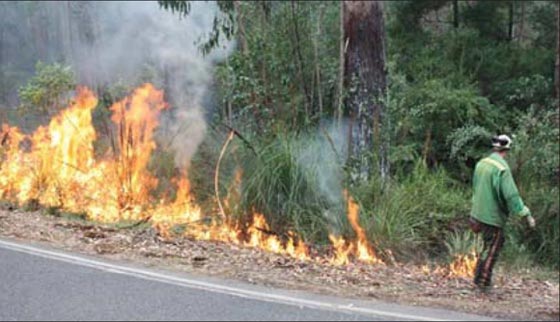 Bureaucracy anxiety But apart from seeing the bushfires take out some seriously beautiful areas and then more seemingly pointless destruction perpetrated by the fire fighting agency, the local communities of Goongerah, Bonang and Tubbut at times had frustration levels reaching catastrophic. The fires were easy to deal with next to the fire bureaucracy. The genuine assistance, good work and info sharing was at times contrasted by the very same criticisms that we have heard from every other fire affected community since 2003; bad communication skills, conflicting information, road closures and refusal to let people in or out despite DEPI coming and going freely, promises of help and then when needed most tankers and crews pulled out. Whether people were brown rice or beef eaters, the experiences were much the same. Maybe this will never change. The reality is that there is a lack of resources (remember when Baillieu sacked 500 DEPI staff on taking government?), ever changing personnel, confusion dressed up as ‘control’ and a number of cowboy operators and controllers that can make the fires themselves seem like a friendly visitor. The real victims But all this pales into pettiness when compared to the real victims. The most tragic losses, the most unbearable suffering that was rarely mentioned, were endured by the wildlife. There were no radio alerts, no fire bunkers, food parcels or medical aid for them. If they weren’t killed outright, thousands of others would have suffered horrific burns to their feet, tail and lungs, exposure, hunger, infection and a slow death - or maybe a slow recovery. Much of our surrounding forests have been taken by the flames of one sort or another. But some parts were less severely burnt and the healthy ecosystems will come back in time – albeit a very long time. East Gippsland has been the last stronghold for so many of the forest dependent wildlife that has now become rarer since the 3.5 million ha of fires over the past 11 years. Gliders and owls in particular would have to be in major decline, but no one is researching these impacts, certainly not the government! While communities are now offered counselling and ‘pamper days’, and while they rebuild fences and deal with insurance companies, the wildlife and forests of Eastern Victoria that have coped with lightning strikes and fires for thousands of years, are at a critical crossroad. Check out the two pages of photos for a little insight into those 53 days at the EEG photo gallery of the event and the aftermath. http://www.eastgippsland.net.au/?q=gallery/fires-2014&page=1 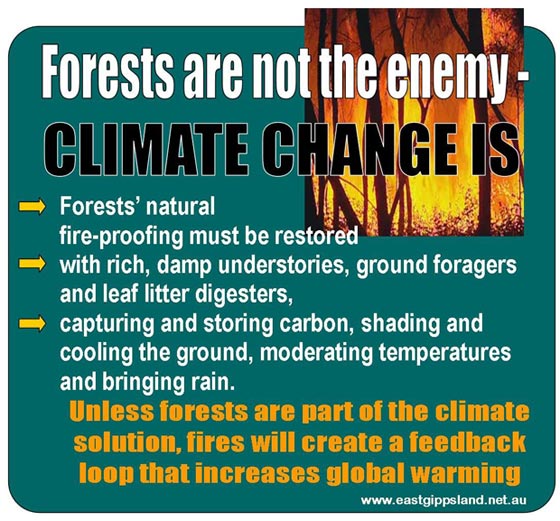
Coastal incineration plan This planned burn is not an isolated case of cowboy vandalism. The DEPI proposal to burn a 6,000ha piece of coastal old growth in the Croajingolong National Park includes the Barga Reference Area. Reference Areas are set aside as untouched landscapes and must not be interfered with. Called the Old Coast B burn, it’s between Sydenham Inlet and Tamboon Inlet. This is a high risk fire and would be difficult to control as the land is peaty and there are few access tracks within it. It has no history of fires, and no surveys for wildlife, let alone plans for their protection. While the vegetation is very fire-proof (lightning strikes don’t take), it has peat beds that could catch alight and burn for months into the next summer season. It is likely habitat for federally listed threatened species yet there has been no surveys undertaken. This deliberate lack of knowledge allows a potentially destructive burn to avoid having to seek federal approval. There could be populations of Smokey Mouse, Ground Parrots, Southern Brown Bandicoots and the Eastern Bristle Birds, Eastern She-oak Skink, Grey-headed Flying Fox. Calling this an ‘ecological burn’ but having no idea of what’s in there is deceitful. If this burn goes ahead, it will be blind eco-vandalism. Parks, reserves and large areas of coastal heathlands and forests are soft targets for meeting the absurd 5% burn figure. They can have huge ecological impacts that wipe out vulnerable species, especially in areas like this. You can write to the manager of DEPI in Orbost – Steve deVoogd Steve.Devoogd@dse.vic.gov.au Ask that decent surveys be carried out by experts, peat beds are mapped, a risk assessment be drawn up, a detailed copy of the burn plan supplied, and if all the necessary precautions are taken and the fire goes ahead, that adequate aerial water bombing capacity be on standby. Due to this area being so valuable environmentally, pre and post burn surveys need to be carried out on a wide range of values, not just plants. New science and research What cranked up the heat across SE Australia? 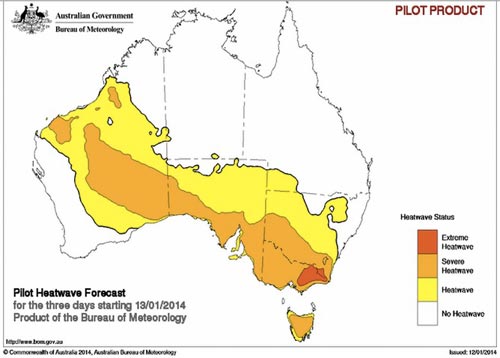 Check out the extreme heatwave down in Gippsland just before the January fires started. It was due to a cyclone and intense low pressure system up in the Kimberleys. This will happen more frequently now as our politicians floor the accelerator of climate change. Read why the heat is being cranked up here Old trees store more carbon Old trees are growing faster, storing more carbon as they age, yet another study finds: "Rather, rapid growth in giant trees is the global norm and can exceed 600 kg (1,300 pounds) per year in the largest individuals," Read more on the report here. State of the Environment Report for Victoria - not good. 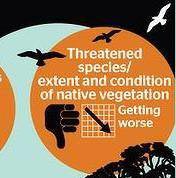 This report from October 2013 shows 65% of Victoria’s state forest areas are zoned to be logged. But with unlogged thin corridors and isolated steep slopes within that zone, it means about 45% can be stripped of its forest and wildlife. If you remove 2/3rds of a body's parts, the 1/3rd of bits left will hardly be viable. You can read a summary of the report here. Read The Age article here and download the entire report here How forests carry out their own fire suppression management. How did forests ever cope before the era of government planned bushfires? Forests had many brilliant systems in place that digested leaf litter, kept the understorey damp and a layer of nutrient rich humus at ground level, all operating with clever symbiotic relationships between plants, animals and fungi. This ground level layer is also the bottom of the food chain for so much of our forests. Read just a selection of fascinating extracts from research on how important these ground layer ecosystems are – and how vulnerable they are to planned government burns. From Blue-tongued Lizards to Mallee Moths and fungi, these essential and unsung heroes of fire suppression are often totally wiped out in regular burns click here to learn more. 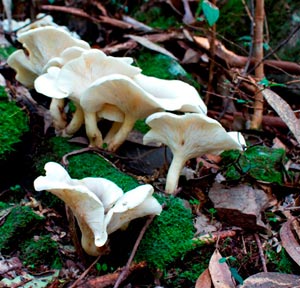 The many talents of Fungi The many talents of FungiWe always knew fungi were critical components of a forest - but this talk shows fungi having talents way beyond soil/nutrient makers and holders. This fast talking guy's info is mind-boggling. Well worth the 17 minutes of watching. Dingo poisoning should be stopped to protect native mammals  Poisoning of dingoes - the top predators in the Australian bush - has a deleterious effect on small native mammals such as marsupial mice, bandicoots and native rodents, a UNSW-led study shows. The research, in forested National Parks in NSW, found that loss of dingoes after baiting is associated with greater activity by foxes, which prey on small marsupials and native rodents. Read more here.
Poisoning of dingoes - the top predators in the Australian bush - has a deleterious effect on small native mammals such as marsupial mice, bandicoots and native rodents, a UNSW-led study shows. The research, in forested National Parks in NSW, found that loss of dingoes after baiting is associated with greater activity by foxes, which prey on small marsupials and native rodents. Read more here.
Legal news Forest protesters get off lightly People charged under new regulations for forest blockading were heard in the Orbost Court in early March 2014. Most of the blockaders received good behavior bonds and no orders were made to cover VicForests costs. However, VicForests managed to complete the total destruction of the old growth forest stand at Mt Jersey. On a similar note, eight Knitting Nanas of Toolangi (KNoT) faced the clogged court system in Ringwood Magistrates Court for knitting in a Central Highland's logging coupe in late 2012. The new penalty for protesting in Victoria is set to increase to between $3,000 - $8,000 maximum. Some of the Nanas were placed on a diversion order and asked to donate $50 to a Landcare group. KNoTs Facebook page is here. Protester laws toughened by Napthine 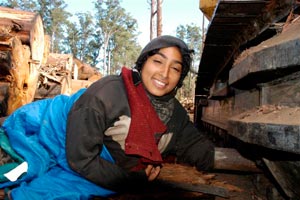 Last November Premier Napthine brought in new changes to existing laws that deal with protesters in forests and on our wetlands. These were couched in terms of ‘public safety’ rather than environmental atrocities protection. The changes include:
Court appeal proves that Victoria’s laws don’t protect endangered wildlife. The Leadbeaters Possum court case run by Central Highland group MyEnvironment that challenged the destruction of prime habitat was initially lost. In a bold move by MyEnvironment that decision was appealed but lost on a technicality. Shamelessly, Napthine and Walsh are now pushing ahead to weaken protection laws even further. State logging code rewritten to wipe out accountability (and wildlife) What do you do as a corrupt government that is caught out breaking the law? Alter those laws of course. The planned changes to the logging code that comes under the Sustainable Forests (Timber) Act are an even more weakened version of the already weak Code. Public comment closed last week but we know these processes are a mere formality. 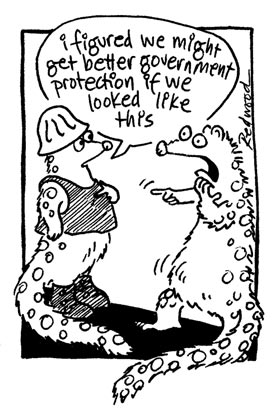 Here are some examples. Here are some examples.
Abbott plans to rewrite laws to let Fed env minister ignore environmental advice Early in February 2014, a Senate inquiry paved the way for the Parliament to give Environment Minister Greg Hunt legal immunity against future legal challenges to his sloppy decisions on mining or development projects. This seems to be as a result of the legal challenge to his decision to approve mining in Tasmaina’s Tarkine forests. If it passes, the move will protect the government from being taken to court over the Abbot Point dredging scheme, the Curtis Island gas project, or any other environmentally contentious development in Australia. More extraordinary is the fact that the government (with Labor’s help) has pushed the legislation through to safeguard an earlier blunder made by former Labor environment minister Tony Burke. Why? Because it will protect Greg Hunt from being challenged over deliberate or negligent decisions that do not comply with the law. Environmental boycott campaigns could be made illegal. Groups such as Markets for Change and GetUp! that run market-based campaigns could be liable for prosecution under consumer law if the Abbott government gets it’s way. The ethical consumer is taking over where corporate and governments fail. Campaigns that help alert buyers to what products are destroying the planet are becoming very effective. Markets for Change has been especially effective against irresponsible wood and paper products. Abbott is set to declare this democratic right to encourage responsible purchases illegal! Read more here.
If you like what we do, or if you feel outraged and want to help somehow you can donate here EEG provides the most enviro-bang for your buck – and we work 7 days a week – no holiday pay, no office rent, power bills, wages or overheads.  |